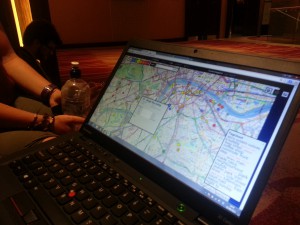Posted on behalf of Shreeya Nanda, Deputy Editor for Biology and Medicine, BioMed Central
At this year’s BMC Day, the once-yearly company bonding event, we got to be citizen scientists, participating in projects ranging from classifying cancer cells on a computer screen to venturing out into the unknown (not really, it was just a park in Vauxhall) to categorise trees. For some, conducting scientific research was a novel experience, for others it probably brought back memories (hopefully not painful ones) of previous lives in laboratories. But I think I can safely say that for all of us, it was an interesting and rewarding experience.
Citizen science, as the name suggests, is scientific research conducted by amateurs and non-professionals, and as a concept has been around since the early 1900s. In more recent times, scientist have harnessed the power of the public not only to analyse data gathered by professional researchers, but also to collect data on a larger scale than perhaps would otherwise be possible. The citizen scientists at BioMed Central had a choice of participating in either data collection projects such as Wide Noise and the Opal Tree Health Survey, data analysis ones such as Zooniverse’s Galaxy Zoo and Cell Slider projects, or a community project such as WheelMap.
The Wide Noise project, run by Mathias Stevens in UCL’s Extreme Citizen Science lab (ExCiteS), involved using a mobile phone app to record the level of noise in an area thereby contributing to a noise map of the world. The app allows one to take a recording of the ambient noise and then classify it (in terms of whether one loves or hates the noise, whether it is natural or man-made etc.) before sending a report. Similarly, the WheelMap project initiated by Louise Francis, also of ExCiteS, uses an app to map the accessibility of the local area for disabled users, thus helping them to navigate the city with greater ease.

The main aim of the Opal Tree Health Survey, which is one of the largest national citizen science projects, is to get citizens to gather information on trees in their local area, specifically identifying tree species, examining trees for signs of poor health and monitoring for pests and diseases. As the project organiser Eleanor Reast points out in this Q&A, “By having more people out on the ground looking out for pests and diseases the public will be acting as an early warning system helping the authorities spot potentially devastating threats becoming established in this country”.
Unlike the above projects, which involved exploring and mapping local areas, the Zooniverse project enabled participants to virtually explore the universe albeit on a computer screen with tasks ranging from classifying galaxies to animals in the Serengeti. Citizen scientists also received online training in distinguishing cancerous from non-cancerous cells and tried their hand on real-life cancer data through Zooniverse’s Cell Slider project. You can read some more about Zooniverse, specifically how it came about, in this guest blog by Robert Simpson and Grant Miller.
It would only be fair to add that there are limitations to citizen science, for example, it has been suggested that since the participants usually lack training in research protocols, they may inadvertently introduce bias into the data. I know I felt that the noise classification aspect of the Wide Noise project was so subjective that it might be less than useful for the researchers. However, the key here is ‘consensus’ and if citizen scientists are not in agreement about the classification of a galaxy or a cancerous cell, the project runs for longer to collect more data. Also, by getting everyone involved, citizen science brings science down from the ivory tower and makes it accessible to the average person, which trumps any limitations in my opinion.
This basic ethos of citizen science, i.e. accessibility, also sits well with the open access movement. And it is particularly satisfying to see the results of such initiatives published in an open access journal. Biome covers one such article, published in Genome Biology, in which the authors describe Open-Phylo, a freely accessible crowd computing platform that enables scientists to use crowds of gamers to assist in solving one of the most fundamental problems in genomics, the multiple sequence alignment problem. Gamers have also helped to further our knowledge of the structure of RNA molecules, in particular the role of the primary sequence in determining the structure, through the online game EteRNA. Tom Rowles, the Executive Editor of BMC Biochemistry, spoke to the top-ranked players and you can read his report here.
The huge public interest in these and similar projects suggests that citizen science is here to stay, and I recommend you pick a project that catches your interest and dive right in. Our experience tells me you won’t regret it.

The citizen science is a good way to do interesting things.